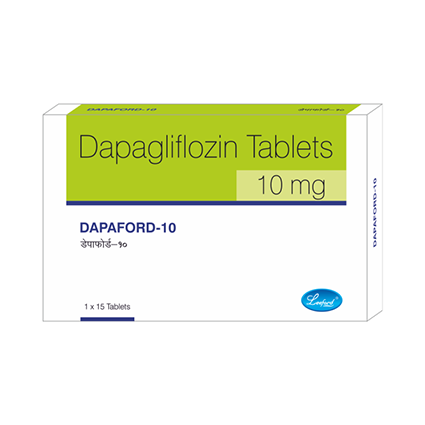Overview:
If you're living with type 2 diabetes, you
know how important it is to maintain stable blood sugar levels. Among the
growing list of antidiabetic medications, Dapaford 10
Mg, containing Dapagliflozin, has emerged as a reliable option to
support better glycemic control. But what exactly is it, how does it work, and
is it safe for you?
In this article, we break down everything you need to know
about Dapaford 10, including its mechanism, benefits, risks, and frequently
asked questions—all backed by trusted medical sources like the Mayo Clinic,
NIH, and WHO.
Dapaford 10 Mg (Dapagliflozin) helps manage type 2 diabetes,
with expert-reviewed facts on dosage, benefits, and precautions.
What is Dapaford 10 Mg?
Dapagliflozin 10 Mg is a prescription oral tablet that
contains Dapagliflozin, a sodium-glucose co-transporter 2 (SGLT2) inhibitor. It
is primarily used to:
- Lower
blood sugar levels in adults with type 2 diabetes
- Reduce
the risk of cardiovascular events in high-risk patients
- Support
weight
loss and blood pressure control as secondary benefits
Unlike insulin or sulfonylureas, Dapagliflozin works by
helping your kidneys remove excess glucose through urine, without forcing
insulin production.
How Does Dapaford 10 Work?
The SGLT2 inhibitors like Dapagliflozin target glucose
reabsorption in the kidneys. By blocking this mechanism, the drug increases
glucose excretion and decreases blood sugar levels naturally.
Benefits:
- Reduces
HbA1c (glycated hemoglobin) levels
- May
promote weight loss due to calorie loss via urine
- Can
help lower systolic blood pressure
- Decreases
the risk of heart failure in people with cardiovascular issues
According to the National Institutes of Health (NIH),
dapagliflozin is especially helpful for people who haven’t reached their target
blood sugar levels with metformin alone.
Who Should Use Dapaford 10?
Dapaford 10 Mg is typically prescribed to:
- Adults
with type 2 diabetes mellitus
- Patients
needing add-on therapy when lifestyle changes and other medications aren’t
enough
- Individuals
at high risk of cardiovascular complications
- Some
patients with chronic kidney disease (CKD) under specific guidelines
Who Should Avoid It?
- Patients
with type 1 diabetes
- Those
with severe kidney impairment
- Individuals
with recurrent urinary tract infections (UTIs)
- Pregnant
or breastfeeding women (unless advised by a doctor)
Dosage and Administration
The usual starting dose of Dapaford 10 is 10 mg once daily,
taken with or without food. It's important to take the tablet at the same time
every day for optimal results.
Always follow your doctor’s dosage instructions.
Self-adjusting doses can be harmful.
Side Effects of Dapaford 10
While Dapaford is generally well tolerated, like any
medication, it comes with potential side effects.
Common Side Effects:
- Urinary
tract infections (UTIs)
- Increased
urination
- Thirst
and dehydration
- Genital
infections (especially in women)
Serious Side Effects (Seek medical help immediately):
- Ketoacidosis
(a rare but serious complication)
- Low
blood pressure
- Severe
kidney problems
- Fournier’s
gangrene (a rare genital infection)
As per the Mayo Clinic, the risk of side effects increases
in elderly patients, those with kidney impairment, or those taking diuretics.
Precautions Before Starting Dapaford 10
Before taking Dapaford 10 Mg, inform your doctor if you:
- Have
a history of bladder infections
- Are
you on blood pressure medications or diuretics
- Have
liver or kidney problems
- Are
you planning a pregnancy, or are you breastfeeding
- Follow
a low-carb or ketogenic diet
You should also stay hydrated and monitor your blood sugar
regularly to avoid complications.
Interactions with Other Medications
Dapaford 10 may interact with:
- Diuretics
(may increase the risk of dehydration)
- Insulin
or insulin secretagogues (may increase hypoglycemia risk)
- Rifampin
or other enzyme inducers (may reduce Dapagliflozin effectiveness)
Discuss all your current medications and supplements with
your healthcare provider to avoid adverse reactions.
Real-World Evidence and Research
Clinical trials and real-world studies have shown that
Dapagliflozin effectively reduces HbA1c levels by 0.5% to 0.8%, while
supporting weight loss of 2–3 kg over several months. The DECLARE-TIMI 58
study, published by The New England Journal of Medicine, highlighted its
cardiovascular benefits in diabetic patients.
FAQs
1. Can I take Dapaford 10 with metformin?
Yes, it’s commonly prescribed as an add-on therapy to
metformin for better blood sugar control.
2. Is Dapaford 10 safe for elderly patients?
Caution is advised due to the higher risk of dehydration and
kidney function decline. Regular monitoring is essential.
3. How long does it take for Dapaford 10 to show results?
Most people begin to see improved blood sugar levels within
1–2 weeks, but full effects may take 4–8 weeks.
4. Can Dapaford 10 help with weight loss?
Yes, weight loss is a potential side benefit due to
increased glucose loss through urine.
5. Do I need to adjust my diet while on Dapaford 10?
A balanced diet low in refined carbs is recommended. Avoid
dehydration and consult a dietitian if needed.
Final Words
Dapaford 10 Mg (Dapagliflozin) offers an effective and
innovative way to manage type 2 diabetes, especially when combined with a
healthy lifestyle and regular monitoring. While it’s not suitable for everyone,
many patients find it improves not just their blood sugar levels, but also
their cardiovascular health and overall quality of life.
Talk to your doctor to find out if Dapaford 10 is right for
you. Never start or stop a medication without medical supervision.
For more information, visit Lovemymed.com

Comments
Post a Comment